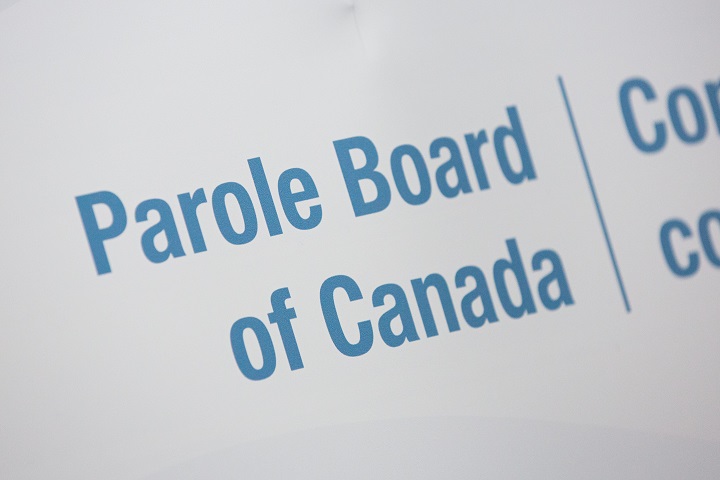Parole Board of Canada employees were fearful of threats after it was revealed a mass killer in Saskatchewan was on statutory release at the time of last year’s rampage, emails show.

The emails in partially redacted documents, obtained by The Canadian Press under the Access to Information Act, show staff at the Parole Board of Canada were cautioned about their safety and told to remain vigilant following threats made to a Saskatchewan office after the stabbings.
Eleven people were killed and 17 were injured in the attacks on the James Smith Cree Nation and in the nearby village of Weldon on Sept. 4, 2022.
Myles Sanderson, 32, was arrested four days later and died in police custody.
It was widely reported during the manhunt that Sanderson, who had a record of violent assaults, had received statutory release, which kicks in when an offender has served two-thirds of a prison sentence.
The killings raised questions over why Sanderson was released and how he managed to remain free in the months leading up to the attacks. Emails show that along with increased public attention and criticism, the parole board received “a few concerning phone calls” about Sanderson’s release, which were reported to Saskatoon police.
Emails to Jennifer Oades, the chairperson of the parole board, on Sept. 8 note a phone call to the Saskatchewan parole board office. The contents of the four-minute call are largely redacted, but it prompted swift action inside the parole board.
“This is quite worrisome,” Oades wrote in an email about the call.
Staff were notified in an email later that day to take action to ensure their safety.
They were advised to use alternate routes to work or change the times they would leave. The email said staff should leave the building in groups or consider working from home.
“Please remember to be vigilant and keep an eye out for any suspicious activities or individuals in your surroundings,” the email to staff said.
It also cautioned people to make their employee identification cards or lanyards less visible and to avoid using branded items like coffee mugs. It said they should revisit having social media accounts that might identify them as a parole board employee.
“Given recent events, it is recommended that you reduce your visibility as a PBC employee while outside of secure work zones,” the email said.
One email sent to Oades two days after the stabbings expressed shock at the fact Sanderson had been released, saying the parole board needed to answer to the public.
“How many more of these (Parole Board of Canada) mistakes are out there?'”
The parole board said in a statement that it sometimes receives feedback that contains “abusive” language over its decisions.
In the case of the worrying phone call, the board said local police contacted the individual and “determined that there had been no intent to threaten the board.”
Parole board employees were also closely watching news reports about Sanderson’s release, emails show. They noted the backlash and shared concerns about the public’s understanding of statutory release, which imposes conditions on offenders to help with their reintegration into society.
Sanderson’s parole documents show he had a lengthy criminal history, including 59 convictions as an adult. He received statutory release in August 2021 from his first federal prison sentence of more than four years.
Four months into his freedom, Sanderson was found to have been lying about his living arrangements and his release was suspended.
In February 2022, the parole board cancelled that suspension and Sanderson again received statutory release with a reprimand. Three months later, however, the Correctional Service of Canada deemed him to be unlawfully at large, and a parole officer issued a warrant for his apprehension.
After the deadly stabbings, then-public safety minister Marco Mendicino weighed in on Sanderson’s release from prison, saying “there were a number of significant flaws in the system here that have to be addressed.”
The Correctional Service of Canada and the Parole Board of Canada launched a joint investigation into Sanderson’s release. One briefing note shows a written report was due no later than March, but in separate statements both the parole board and prison service say they expect to share the results this fall.
“The length of time to complete an investigation varies according to the complexities of the case and whether there is an ongoing police investigation or criminal proceeding,” wrote parole board spokeswoman Iulia Pescarus Popa.
The joint investigation is intended to look into why and how Sanderson was released from prison and whether the proper processes were followed.
Betty Pottruff, the parole board member who signed off on the Sanderson decision, voiced concern about the heightened interest and her own safety as the joint investigation progressed.
In an email in January, she requested to have the assistance of a department of justice lawyer for the joint investigation.
“There was already a threat toward board members that caused concern in the fall and as emotions resurface, the risks continue or increase,” Pottruff said.
“I expect that this focus on me as an individual board member will continue and increase as the reviews go forward.”
This report by The Canadian Press was first published Sept. 25, 2023.




Comments